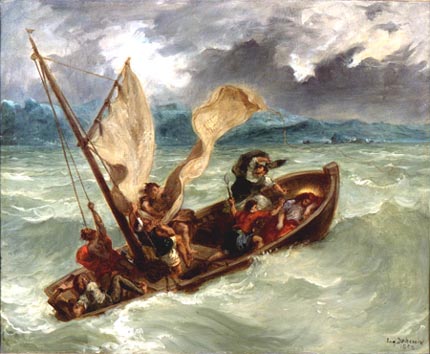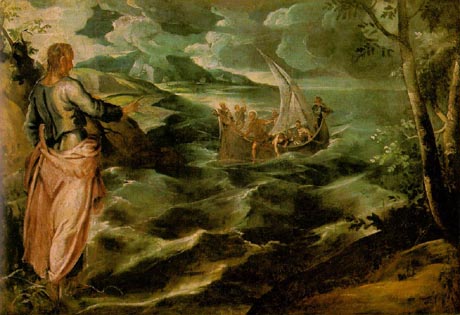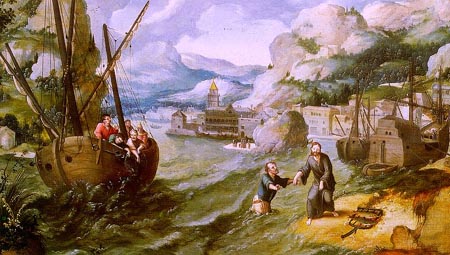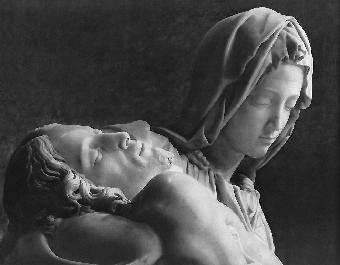«
the sea of galilee
»

june 17, 1999
holy christian sights in the upper galilee
well, with a good night's sleep in quiet machanayim, i take advantage of my two
day car rental and start out the next morning, heading south along the west
coast of the “kinneret” (hebrew for the sea of galilee). i'm once again
following eran's and rivka's itinerary, tracing the steps of jesus as a young
man building his faith and his flock. my first holy site is tabgha, a small
seaside village with an immaculately restored church and courtyard where jesus
is reputed to have performed several miracles, the most glorified being the
turning of a stone into loaves and fishes. the sacred stone itself sits in the
middle of the sanctuary, and a new busload of oklahoman christians arrive just
as i'm entering the church. i've performed something of a miracle myself, well
at least a minor transformation, where just outside the holy grounds in the
parking lot, i've changed from torn-off short pants into long,
religiously-correct ones. no problem - a required act of modesty and respect.

i follow along the trail of miracles – and busses – to the place where jesus
gave his sermon on the mount, where he walked on water (the kinneret) -- and i
come to the church of st. peter between tabgha and capernaum, where jesus
supposedly instructed his friend and disciple, peter, to build a simple seaside
place of worship. again there are swarms of tourists, this time from japan,
finland, and nebraska, and they are snapping pictures, singing hymns, and
vociferously praising the lord both inside and outside the church. i go in, wait
in line, and stand at st. peter’s pulpit. i ask one of the expert japanese
camera clickers to click one of me. he does. i look around guiltily. somehow, i
feel like an imposter.

next, on to capernaum, where jesus reputedly lived and preached. it looks like a
typical roman ruin site, but the old church (once again of st. peter) has been
technologically advanced with a surreal glass dome built visibly above the old
stone foundation. again, there gift shops, photo opportunities, and busloads of
tourists and pilgrims, all sweaty, eager, and happy to be here. i climb amidst
the ruins, take the mandatory photos, and again feel a little odd walking in the
steps of jesus. i mean, even though i’m a contentious, reluctant, and
non-practicing jew, i have been subtly and subconsciously brainwashed by my
culture to bristle and reject the very existence of jesus christ. i mean, if
jesus wasn’t actually “the messiah” (savior”), for whom the jews are still
waiting, then somehow this young jewish rabbi who was vilified by his fellow
jewish rabbis and crucified by the occupying roman authorities, was indeed, a
false idol of worship. then somehow, the whole subsequent religion and belief
system, “christianity”, its entire liturgy and creation of a “new testament” –
is all suspect to a jew. there is part of his psyche that just shuts down and
closes off - at the very mention of the name, “jesus christ”. or so this one
reluctant, tourist jew recognizes – and senses. in himself. i recognize the same
feeling of hesitation and resistance that i saw in yaron in akko, as he refused
to visit the muslim mosque of “the other”. and here i am, only a few hundred
kilometers away, albeit with another religion, another prophet, and another
house of worship, and i’m feeling almost the same thing. yes, i press on –
trying to overcome my resistance and upbringing, but my, aren’t we
self-righteous, fearful human beings all so much the same?

nevertheless, i'm impressed with the christian tourist industry. i can't say
i've personally had a spiritually uplifting experience, nor been moved by
walking in the steps of the lord, but yes, it has afforded me some difficult
self reflection. i drive a little further north along the sea, and i see a large
multi-pink-domed orthodox looking church. there are no tourist signs and i
discover - no public entry at all. this intrigues me. i drive off the main
seaside road onto a dirt path for about three quarters of a mile and park my
car. it's quiet. there are no people to be seen anywhere. a huge black wrought
iron gate protecting the property is shut, but its padlock is open. i don't
think of removing the padlock, but i see a bell. i ring it. and wait. after
several minutes, a small man in dark monk's attire comes walking slowly up the
long path. i have the distinctly uncomfortable feeling of intruding. it's very
hot and he's dressed very warmly in black. he opens the gate. "excuse me," i
stammer, "i hope i'm not bothering you, but i wonder if i might see your church
and its grounds. it looks really beautiful from the road." yah", the small man
says in a heavy greek accent, "you come in." he opens the gate with a huge
cartoon-like padlock key. he has very intense black eyes, and there is a strong
and distinct smell of - grapefruit - emanating from him.

we walk down the straight cloistered path together, and he shows me around the
grounds. he is the only person living here at the secluded monastery. he tends
the entire property himself. he cares for the beautifully manicured gardens:
climbing red and yellow bougainvillea, well-pruned pastel-colored roses,
paradise-arching hibiscus, other flower varieties i've never seen. we enter the
newly painted sanctuary. there are candles lit and, what sounds to me, like
gregorian chant music piped in through a very fine sound system. the entire
interior of the sanctuary has been painted with brightly colored panels
depicting scenes from the life of christ. the art work is detailed and striking.
i wonder if this sweet grapefruit-smelling man has done this himself as well.
"no," he says modestly, "people from my country come do it." he seems open and
friendly - in a monk-like way. i ask him his name. "irinahos", he says. i tell
him mine. he seems less interested in this; perhaps i'm not the only
tourist/intruder who's interrupted one of his days.

i figure - well, i'm here. how many times will i have a private audience with a
monk. of course, it's not the pope, but it's probably the closest i'll ever get.
i awkwardly muster up my courage and ask, "would you mind telling me the history
of the orthodox church?" "yah, sure," he says, "how much time you have?" i
laugh; irinahos has a sense of humor - not bad for a hermetic greek orthodox
monk living alone in secluded pink-domed monastery. we proceed.

i learn about jesus, the apostles, the evangelists (matthew, luke, john - who
wrote the new testament), and the secretive followers of christ who spread the
word for three hundred years throughout the roman and byzantium worlds, living
in caves, hiding from prosecutors, until constantine, holy roman emperor in 325
ad, officially recognized christianity and spread it throughout the empire. now,
it gets interesting, and nasty, according to irinahos, who explains to me that
rome, only one of the five equal centers of christianity created by constantine,
decides to politicize the church by claiming its preeminence over the other
four, making itself "separate and above", establishing a "catholic" church,
declaring a "holy war" and “crusade” against the muslim infidels, and thereafter
imposing its intolerance, inquisition, arrogance, and lust for power upon the
rest of the religious and secular world - with its torture, burning, and
slaughter of heretics, its expulsion of jews from spain and portugal, etc. etc.
that is, until martin luther comes along with his 16th century lutheran
reformation, starting the birth and spread of reformist protestantism throughout
the world - with all its multifarious offspring and proselytizing progeny.
leaving, according to irinahos, the original byzantium, "orthodox" church in
constantinople, which soon establishes a strong center in greece, speaking
perhaps the original orthodox language of the church, greek, until it migrates
and is translated into russian and balkan versions etc. etc. that is, until a
new international adversarial conflict is created between christians (orthodox)
and muslims for the next millennia or two - ongoing today in sites such as
kosovo (muslim albanians and orthodox serbians), bosnia, iraq, turkey, etc. etc.
-- slaughter upon slaughter -- from generation to generation - all in the name
of god.

another history lesson. this from a small greek orthodox monk living alone in a
pink-domed monastery in the holy land - his breath smelling intensely from -
grapefruit. why does his lesson sound so familiar?



|
|
|